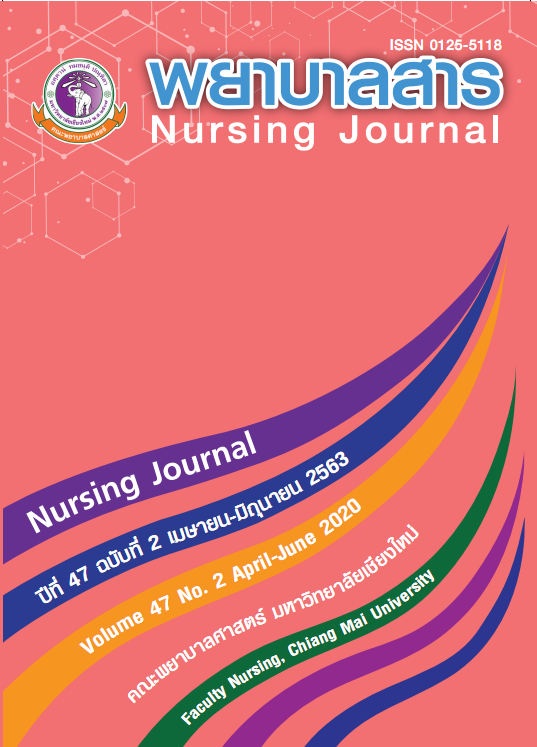Effects of Using a Critically ILL Patients Assessment from According to FANCAS Concept in Nursing Practicum Course
Keywords:
Critical State, Fancas Assessment Form, SatisfactionAbstract
Assessing critically ill patients with FANCAS is used in the nursing practicum course. The evaluation form is useful for sequencing patients’ health problems and covering life-threatening issues. This descriptive research was aimed to evaluate the levels of knowledge and ability, opinions, and satisfaction among third-year nursing students and nursing instructors towards the critically ILL patients assessment form. The Fancas assessment framework by June C. Abbey (1979) served as the conceptual framework for this research. This research was conducted with 146 junior-year nursing students and 8 nursing instructors selected by the purposive sampling method between June and July 2019. Data were collected using a five-rating scale questionnaire comprising three parts: 1) knowledge and ability of nursing students to used the critical patient assessment form; 2) opinions of nursing students to use of critical assessment forms; and 3) satisfaction of nursing students to using the critical patient assessment form. The whole instrument was tested for content validity by three experts and the content validity index was 0.92. Cronbach’s alpha coefficient reliability was 0.87. Data were analyzed by using descriptive statistics, Chi-square, and test for statistical differences (ANOVA).
The research findings were as follows:
- Nursing students had a moderate level of the knowledge and ability to use the Critical Care Assessment Form ( = 3.38, SD = .74). In addition, the evaluation by nursing instructors found that the ability of nursing students was moderate level ( = 3.06, SD = .55).
- The opinions of nursing students and nursing instructors about using the Critical Patient Assessment Form constructed the Fancas model were high level, ( = 3.96, S.D = .68) and ( = 4.19, S.D = .71), respectively.
- Nursing students’ satisfaction was high while using the Critical Care Assessment constructed form, the Fancas model (= 3.83, SD = .69). Also, nursing instructors had a high level of satisfaction with the use of the crisis assessment constructed form ( = 4.61, S.D = .51).
- There were no statistical differences in knowledge, ability, comments and satisfaction of nursing students and the result of competency evaluation of students by nursing instructors.
Preparing nursing students for clinical practices and developing confidence is important for nursing education. Therefore, the results of this research could be offered to enhance nursing students’ training program in Simulation Base Learning.
References
Bundasak, T.,Chaowiang, K., & Jungasem, N. (2018). Affecting F actors on Nursing students Anxiety while Practicing in Intensive Care Unit. Journal Prapokklao Hosp Clin Med Educat center. 34 (1), 6–15. (In Thai)
Holloway, N. M.(1979). Nursing the Critically ILL Adult. California: Addison-Wesley Publishing.
Jaramillo, W. A. (2011). Transcribe the lessons of the Adult and Elderly. Bangkok: Nursing Academic Group and the Children’s Nursing. (In Thai)
Limumnuaylap, S. (2013). Nursing of Critical Illness Patients (7th ed.). Bangkok: InternationalScience Depot. (In Thai)
Limumnuaylap, S., & Thamnong, C. (2009). Critical Care Nursing (4th ed.). Khonkaen: Khonkaen University. (In Thai)
Lueklang, A. (2012). Satisfaction and Expectancy to Service of Water Division Personnel of Nong Gnu Lueam Subdistirct Administrative Organization, Chaloem Phr a Kiat District, Nakhon Ratchasima Province. Nakhon Ratchasima : Water Division Personn el of Nong Gnu Lueam Subdistirct Administrative Organization. (In Thai)
Office of the Civil Service Commission. (2009). Defining the performance line. Retrieved from http://ops.sueksa.go.th/wp-
Pathojaruwat, T., Boontoi, T., & Matchim, Y. (2018). Nursing students Experience in an Intensive and Emergency care Practicum. Thai Journal of Nursing Council, 33 (4), 75-92. (In Thai)
Polit, D. F., & Beck, C. T. (2008). Nursing Research: Generating and Assessing Evidence for Nursing Practice (8th ed.). Philadelphia: Lippincott williams & wilkins.
Rungnoei, N., & Seesawang, J. (2016). Effects of Self–developme nt Supportive for the Pre-practicum preparation at intensive Care Unit on knowledge and Skills amon g Nursing Students. Journal of Phrapokklao Nursing Students, 27 (2), 36-37. (In Thai)
Sinthuchai, S., & Ubolwan, K. (2017). Fidelity Simulation base Learning Implementation to Learning and Teaching management. Journal of the Royal Thai Army Nurses, 18 (1), 113-127. (In Thai)
Sisa-at, B. (2010). Preliminary research (8th ed.) Bangkok: Suwiriyasarn. (In Thai)
Sittipakon, S., Kochamat, A., Seubniam, S., & Pongprathet, J. (2017) Effects of High Fidelity Simulation Based Learning on Self–Confidence and Satisfactions among the 3rd Years Nursing Student in Faculty of Nursing Mahasarakham University. In academic conference of Maha Sarakham University 14 th(pp. 600-607). Maha Sarakham: Mahasarakham University. (In Thai)
Thanamethee, W. (2011). The Opinions of people toward Sangha Administration Nongbualamp hu Province (Master’s thesis, Mahachulalongkornrajavidyalaya University). ( In Thai)
Downloads
Published
How to Cite
Issue
Section
License
บทความที่ได้รับการตีพิมพ์เป็นลิขสิทธิ์ของวารสารพยาบาลสาร
ข้อความที่ปรากฏในบทความแต่ละเรื่องในวารสารวิชาการเล่มนี้เป็นความคิดเห็นส่วนตัวของผู้เขียนแต่ละท่านไม่เกี่ยวข้องกับมหาวิทยาลัยเชียงใหม่ และคณาจารย์ท่านอื่นๆในมหาวิทยาลัยฯ แต่อย่างใด ความรับผิดชอบองค์ประกอบทั้งหมดของบทความแต่ละเรื่องเป็นของผู้เขียนแต่ละท่าน หากมีความผิดพลาดใด ๆ ผู้เขียนแต่ละท่านจะรับผิดชอบบทความของตนเองแต่ผู้เดียว






